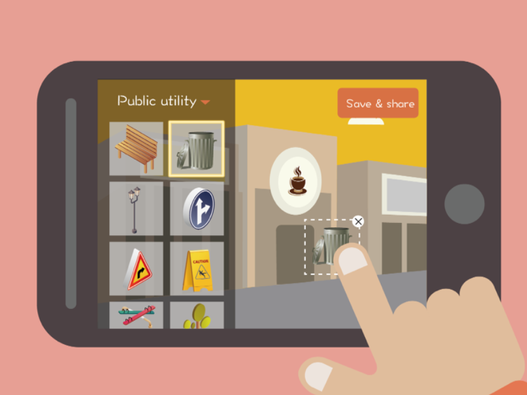Walk!man - the app that engages pedestrians in improving street design
Walk!Man aims to improve the walkability of the city by engaging pedestrians on an interactive online platform that allows them to offer recommendations that will improve walking conditions for pedestrians.
Why improve walkability in China?
Much of China's modern urban planning was centered around the automobile. As a result, the biking and walking conditions of street designs in Chinese cities were made lower priority. However, now that pollution has come to the forefront of issues involving human health, livelihoods, and the livability of Chinese cities, it is becoming more and more important to promote walking as a desirable mode of transportation. This project aims to create more options, and better options, for pedestrians.
Objectives of the Walk!Man app:
Ultimately, our partner Clean Air Asia should be able to disseminate this app and see what types of street design recommendations pedestrians make. This should inform planning decisions and promote a pedestrian-centered street design.
The Walk!Man team is composed of four members, two at Stanford University and two at Tsinghua University. The Stanford team performs research and makes recommendations regarding the app's components. The Tsinghua students are focusing upon the app design and user interface, working to ensure that the app is engaging and user-friendly.
Here is a summary how our research thus far is informing the app design:
We sincerely hope that our research-based app design will help promote walkability on Chinese streets. If you have any recommendations for the Walk!Man project, please leave comments on the International Urbanization Blog
Why improve walkability in China?
Much of China's modern urban planning was centered around the automobile. As a result, the biking and walking conditions of street designs in Chinese cities were made lower priority. However, now that pollution has come to the forefront of issues involving human health, livelihoods, and the livability of Chinese cities, it is becoming more and more important to promote walking as a desirable mode of transportation. This project aims to create more options, and better options, for pedestrians.
Objectives of the Walk!Man app:
- Provide pedestrians with a better understanding of where they can walk
- Educate app users about different aspects of street designs that can improve the walking experience
- Create an app that will be useful in a wide variety of cities throughout Asia
- Encourage users to think critically about the streets on which they walk, and enable them to make useful recommendations for improving the streets
- Allow app users to share their thoughts about the walkability of streets with other pedestrians, creating a pro-walkability community
Ultimately, our partner Clean Air Asia should be able to disseminate this app and see what types of street design recommendations pedestrians make. This should inform planning decisions and promote a pedestrian-centered street design.
The Walk!Man team is composed of four members, two at Stanford University and two at Tsinghua University. The Stanford team performs research and makes recommendations regarding the app's components. The Tsinghua students are focusing upon the app design and user interface, working to ensure that the app is engaging and user-friendly.
Here is a summary how our research thus far is informing the app design:
- We've explored a wide variety of walkability metrics, and we've noted that many walkability surveys merely ask pedestrians for facts about their neighborhoods, rather than soliciting recommendations. Programs that do solicit recommendations from pedestrians typically include an educational component or a way to help pedestrians think critically about what makes the street design good or bad for walkability. Thus, we are working on a design that will walk the app users through their impressions of the street, and help them think about what specific improvements would best benefit the walking route.
- Tools designed for measuring walkability in the U.S. have focused mainly on low-density areas, and therefore may not be directly transferrable to extremely high-density Chinese cities. The China Urban Built Environment Scan Tool has been recently introduced in Hangzhou, and it has adjusted American auditing indices to better analyze high-density areas. As we develop the components of the app, we will keep in mind concerns that may be pertinent on U.S. streets may not be directly transferrable to Chinese streets.
- From analysis of various walkability surveys and projects, we've developed several categories of concerns. We are in the process of determining how these categories can inform the flow of the app. Currently, the categories are Interactions with Vehicles, Pedestrian Accommodations, Comfort and Engagement, Aesthetics, Safety from Crime, and Traffic Safety and Convenience.
We sincerely hope that our research-based app design will help promote walkability on Chinese streets. If you have any recommendations for the Walk!Man project, please leave comments on the International Urbanization Blog

